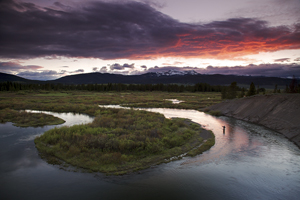Fly Fishing Jazz: The Legacy Factor

Last light. Photo by Adam Barker
MOST MUSICIANS will tell you that their “sound” was born of many influences—other artists that caught their ears, and inspired them to imitate, experiment, and ultimately expand. For example, I’ve always found it interesting how Robert Johnson, Brownie McGhee, and Muddy Waters helped form the guitar playing of Eric Clapton. Before the Beatles, there was Elvis, Buddy Holly, and Chuck Berry. And the broad and dynamic compendium of music created by the Fab Four between 1963 and 1969 still has a massive impact on musicians and songwriters to this day.
That’s also true in jazz. Though the limits are much broader and less influenced by the commercial “hit machine,” standards are standards for a reason. One simply cannot evolve down the jazz path without meeting the ghosts of Duke Ellington, John Coltrane, Louis Armstrong, Miles Davis, and others, in one way or another.
I think that’s also true in fly fishing. Beyond the basic price of admission, getting good at fly fishing (like getting good at playing a horn) requires a certain level of emulation. That’s why we read Lefty Kreh, John Merwin, and others, and it’s why our kids and grandchildren will too.
I am always impressed when I watch Steve Rajeff cast on a practice pond—the straight, level, precise tempo; the focused, efficient delivery; no wasted motion; all physics. You could put Rajeff behind a white screen, and by simply watching the silhouette cast, I would know exactly who that is, every time.
Some years ago, I had the chance to fish with Frank Moore, the dean of all things steelhead (and a mentor to Rajeff), on Oregon’s fabled North Umpqua. Then 86 years old, Frank laced beautiful 90-foot casts across the river, and as I watched him do this, I realized that he was the oak that dropped the acorn for many other great casters, Rajeff, to a degree, certainly among them.
Of course, it doesn’t have to be “textbook” to be effective, or even beautiful. It doesn’t have to come from a legend. And it doesn’t have to revolve around the cast either. I have a certain little wiggle move I do (now without realizing it) when I pick up my fly line to cast. Those who fish with me might think that’s my own hitch, but it actually came from my father-in-law, 25 years ago. The way I now lean into a drift, and make that last micro-mend to give me another foot or so in a run—that came from Denny Breer. There are many people in my casts and drifts now.
I ran into my buddy Pat Dorsey the other day. Pat won’t admit it, but he has a cult-like following of anglers on the Front Range of Colorado. You can tell by watching people nymph fish the South Platte, and how many of them use fluffed-out, dirt brown, Holly Twist yarn strike indicators. I can spot them 50 yards away. I call them “Dorsey disciples,” and I avoid fishing behind them.
It seems to me that the adage that “there’s no such thing as an original fly,” or an original fly pattern, is largely true. And I’ve accepted that that is not a bad thing.
If you endeavor to collect a bit here, a bit there, and then make your own style (or “sound,” as it were), maybe someone will pick that up, experiment, expand, and pass it all along to someone else.
When you think about it, the legacy factor—in music, and in fly fishing—is very cool indeed.











